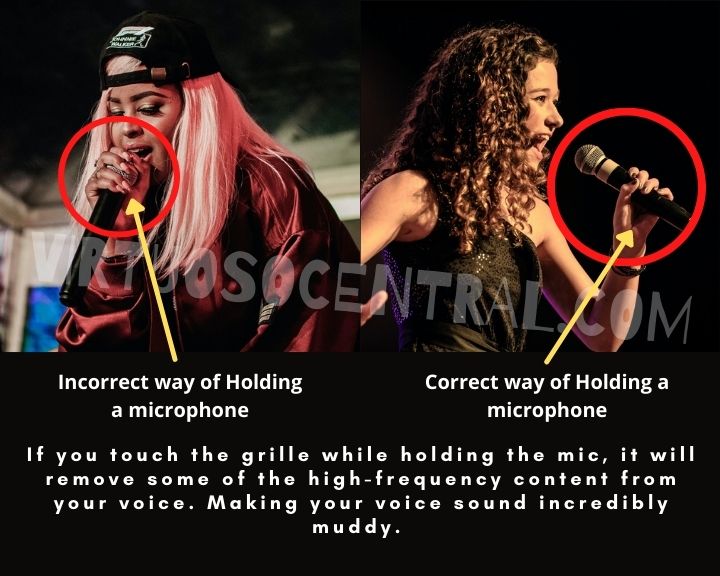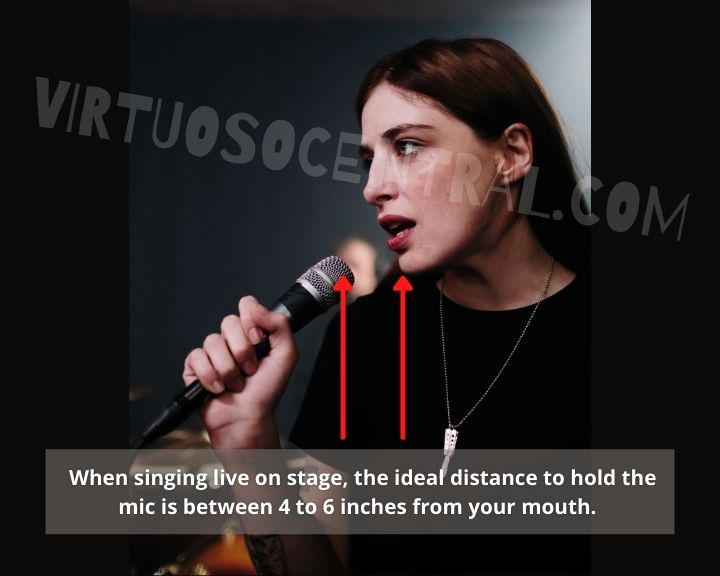As a vocalist, you might feel like your instrument is your voice. While this is true, you need to realize that having a beautiful, well-trained voice will not be enough to have a successful performance. The reason is that even the best of singers can instantly ruin a performance by using the wrong mic techniques.
Even the best sound engineer won’t make you sound good in the mix if you don’t use the mic correctly. Not only does this reflect poorly on him, but it also makes you look bad as well.
So, what can you do to make sure you always sound great when using a microphone to sing or speak?
Here are the 6 best mic techniques for vocals that you should know about:
- Hold the Microphone Correctly Because Your Grip Colors Your Sound
- Good Sound Starts at the Source – Mic Proximity is Very Important
- Use the Proximity Effect to Your Advantage
- Turn Your Head Slightly Away from the mic When you need to Hit High, Loud Notes
- Have a Clear Vision to Communicate With Your Sound Team
- Listen to the People Who are Mixing Your Live Performance – Stay Teachable
In this article, we go over each of these techniques and tips in more detail so that you know the best practices when handling microphones, let’s get started.
1. Hold the Microphone Correctly Because Your Grip Colors Your Sound
One of the most crucial mic techniques for singers is to make sure to hold the microphone correctly. If you hold the microphone in the wrong way, you can make your vocals sound so terrible that the sound technician can’t do anything about it from their mixing console.
Basically, you always need to make sure you hold the mic in the handle. You should never cover the metal grille with your hand while holding the mic because it will change the mic’s frequency response if you do. This means that the mic will overemphasize certain parts of your voice while removing other elements.
Covering the metal grille while holding the microphone will generally remove some of the high-frequency content from your voice and concentrate the mid-frequencies. This will make your voice sound incredibly nasal and, in some cases, muddy, and there is not much that can be changed on the EQ to make it sound better.
This happens because when you sing or speak through a microphone, some of the sound pressure escapes through the back of the grille, where standing waves tend to add up around the capsule.
Covering the grille capsule will add significant resonances that affect the microphone’s frequency response, negatively coloring the sound.
This phenomenon happens due to the sound waves bouncing back and forth between the inside surfaces of the grille without having a quick way to escape. Therefore, emphasizing some frequencies while rejecting others. This frequency unbalance creates resonances that change your voice’s tone, and the worst part is that the sound engineer can’t do much to improve the sound.
This is one of the vital microphone tips I can give you because not only will holding the mic incorrectly impact your sound, but your sound technician also won’t be too pleased with you as you’re making their life especially hard.
If you’re in doubt about how you’re supposed to hold a particular mic, you can always ask the engineer.

2. Good Sound Starts at the Source – Mic Proximity is Very Important
Another critical mic technique for singers or speakers is ensuring you don’t hold the mic too far away from your mouth. Some people tend to hold the mic very far down, and this is a huge mistake because the microphone will pick up your voice via reflections in the room rather than from your mouth, and it also picks ambient noise.
This means that the gain on your mic will need to be turned up a lot to be heard, making it prone to feedback.
When there’s deafening feedback coming out of the PA system, all eyes will be on the sound engineers, and this will reflect poorly on them, although the person with the mic is primarily responsible for the feedback in the first place.
When singing live on stage, the ideal distance to hold the mic is between 4 to 6 inches from your mouth.
Be mindful that your voice will sound overly bassy if you get too close to the mic’s head. Using the correct distance from your mouth will improve the sound of your voice while providing more gain headroom to the person working at the mixing console.
Help your sound engineer out by using the right microphone techniques when singing or speaking.

3. Use the Proximity Effect to Your Advantage
Another thing you should do as a vocalist is to use the proximity effect to your advantage. Microphones tend to boost the low frequencies when the sound source is close to them.
While the proximity effect in isolation could make your voice sound boomy and muddy, it is of great value to the sound engineer when used correctly.
The issue with using vocal microphones is that they also pick up the ambient sound from the loudspeakers inside the venue. This would end up making your voice sound cluttered and less natural, but if you’re getting the added bass from the proximity effect, it can be fixed by using the EQ to compensate and bring your voice back into the natural range.
Since it’s undesirable to have any sound except the voice coming through the mic, sound engineers want to eliminate the ambient sound from the mics as much as possible. And a way to achieve this is by using the proximity effect to our advantage.
The person working on the mixing console can use equalization to reduce the low end coming from the mic by decreasing the gain on the low-frequencies and compensating on the mid and high frequencies to get a natural sounding voice.
The great thing about leveraging the proximity effect is that most of the ambient noise present on the stage and in the venue will be significantly decreased.
This is an example of something that might seem unintuitive from your perspective but makes perfect sense.
Sound reinforcement is a complicated field, and sound engineers have complex knowledge about how acoustics works. It pays off to listen to their knowledge.
4. Turn Your Head Slightly Away from the mic When you need to Hit High, Loud Notes
You generally want to have around 6 to 10 inches of distance between your mouth and the microphone when you’re hitting those high, loud notes as a singer. If the sound going into the microphone is too loud, it can cause the sound to clip. This is when the audio waveform starts to “square off” at the peak.
When the sound goes into the microphone too loudly, there’s not much anyone can do to fix it. Even if you’re in a recording studio where you can do post-processing, there’s not much you can do if your vocal is clipping the mic.
The only solution is to use the correct mic techniques for vocals. Holding the mic at the proper distance is one solution, but it can be challenging to accomplish this consistently, especially when you’re trying to focus on delivering a great vocal.
Another solution is to put the mic slightly to the side of your mouth when you hit those notes. Tilting the mic 45 degrees to either side when singing will help decrease the signal’s loudness when hitting high notes.
This is a much easier technique to get down, and it will ensure you’re not clipping the signal coming from the mic.

5. Have a Clear Vision to Communicate With Your Sound Team
There are many situations on stage where you need to communicate something with the engineer. Most of the time, you’ll either want some element in the mix turned up or down in your monitors.
As previously mentioned, sound engineers like to keep it low-key. This means you shouldn’t draw attention to them during your performance. You should avoid specifically asking them for things through the PA.
Generally, performers will use hand gestures and signals to communicate with the soundman what they want. With that said, they probably won’t appreciate it if you use overly dramatic and exaggerated motions. A good engineer will be able to recognize more subtle gestures.
When sound engineers and performers are on the same wavelength regarding this, they can often communicate without the audience even realizing it.
It may make sense to talk with your sound technician beforehand to figure out how they prefer you to communicate with them from the stage. If you’re unsure what they like, it’s usually best to keep it low-key.
6. Listen to the People Who are Mixing Your Live Performance – Stay Teachable
One of the most critical tips that you’ll ever learn is to listen to your sound technician as they often have decades of experience, and they’re likely to have worked with their equipment for a large part of that time.
This means that the sound engineer almost certainly knows more about their setup than you do. In most cases, it pays off to listen to them. If they tell you to adjust your microphone technique in some way, it’s because they’re trying to help you sound better.
Another reason that you should listen closely to your soundman is because when the band and vocalist are easy to work with, it enables them to focus on getting a better mix.
Sound engineers want to focus their energy on getting the sound levels right, not spending half the night fighting with the vocalist on the correct mic technique. If you treat your sound technicians well and listen to their advice, you’ll sound great.
The Right Mic Techniques for Vocals Will Make You Sound Loud and Clear
If you want to be a singer or public speaker, you’re going to use microphones. While these devices are not quite as complicated as a guitar or drumkit, you’ll still need to master specific mic techniques for vocals if you want to sound your best.
If you remember only one tip from this article, it should be that you need to listen closely to your sound engineer because they know the equipment best, and they will be more than happy to help you if you have any doubts about the technique.
So many people hold the microphone wrong and use various other bad techniques that a sound technician will significantly appreciate you asking for their advice.
If you read more articles like this one, visit our site as we always publish new articles. Do you have questions or comments about our dedicated site, please don’t hesitate to reach out.